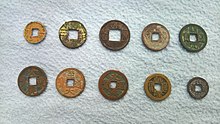List of Chinese cash coins by inscription

Chinese cash coins were first produced during the Warring States period, and they became standardised as the Ban Liang (半兩) coinage during the Qin dynasty which followed. Over the years, cash coins have had many different inscriptions, and the Wu Zhu (五銖) inscription, which first appeared under the Han dynasty, became the most commonly used inscription and was often used by succeeding dynasties for 700 years until the introduction of the Kaiyuan Tongbao (開元通寳) during the Tang dynasty. This was also the first time regular script was used as all earlier cash coins exclusively used seal script. During the Song dynasty a large number of different inscriptions was used, and several different styles of Chinese calligraphy were used, even on coins with the same inscriptions produced during the same period. These cash coins are known as matched coins (對錢). This was originally pioneered by the Southern Tang.
During the Yuan dynasty, largely deprecated copper coinage was abandoned in favour of paper money. This trend continued under the Ming dynasty. Cash coins only contained the era names of the emperor during the Ming dynasty. Due to a naming taboo the term "Yuanbao" (元寶) was phased out from cash coin inscriptions as the founder of the Ming dynasty, Zhu Yuanzhang had the word "Yuan" (元) in his name.
The trend of exclusively using the era names on currencies continued during the Qing dynasty, and all cash coins issued during this period were written in regular script.
Below is a list of obverse inscriptions that were used on Chinese cash coins organized by period and/or dynasty.[1][2][3]
Warring States[]
During the Warring states period, the first precursors of the Chinese cash coins started to appear. These early round coins (圜錢, huánqián) circulated alongside the knife and spade money. As most of these early round coins had round holes, the first "true" cash coins were the Yi Hua (一化) produced by the State of Yan.[4][5] Apart from two small and presumably late coins from the State of Qin, coins from the spade money area have a round hole and refer to the jin and liang units. Those from the knife money area have a square hole and are denominated in hua.[6]
Round hole, no rims, reverses plain and flat[]
List of early round coins produced between 350 BC and 220 BC:[7][8][9][10][11]
| Inscription | Traditional Chinese | Hanyu pinyin | Meaning | Alternative reading(s) | Image |
|---|---|---|---|---|---|
| Gong | 共 | gòng | A city in the state of Liang | None | 
|
| Gong Tun Chi Jin | 共屯赤金 | gòng tún chì jīn | "Gong Pure Red Metal" | 共純赤金 (Gong Chun Chi Jin) |

|
| Gong Ban Jin | 共半釿 | gòng bàn jīn | "Gong, half jin" | None | |
| Yuan[a] | 垣 | yuán | A city in the state of Liang | None | 
|
| Gu | 古 | gǔ | "Old" | None | |
| An Zang | 安臧 | ān zāng | A city in the state of Zhou | None | |
| Qi Yuan Yi Jin | 桼垣一釿 | qī yuán yì jīn | "Qiyuan, one Jin", State of Liang |
長垣一釿 (Chang Yuan Yi Jin) 桼圜一釿 (Qi Yuan Yi Jin) |

|
| Qi Yuan Yi Jin | 桼睘一釿 | qī yuán yì jīn | |||
| Xiang Yin[b] | 襄陰 | xiāng yīn | A city in the state of Liang | 濟陰 (Ji Yin) 畢陰 (Bi Yin) |
|
| Li Shi | 離石 | lí shí | A city in the state of Zhao | None | |
| Feng Ping | 封坪 | fēng píng | Unknown | 陰坪 (Yin Ping) 武坪 (Wu Ping) |
|
| Hou Jin | 侯釿 | hóu jīn | "Hou, (one) Jin" |
